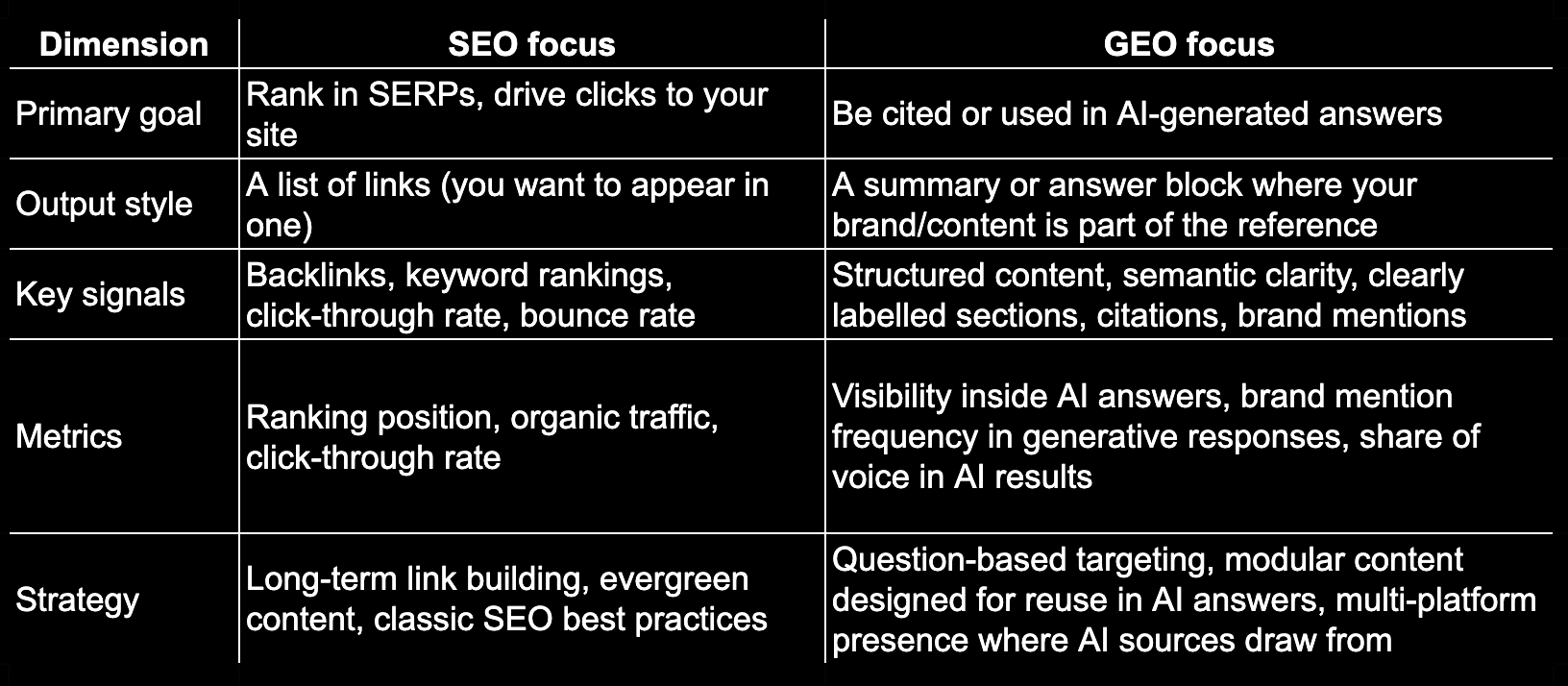SEO vs GEO: What You Need to Know
If you’ve been doing digital marketing for a while, you know how crucial it is to show up in search. For years, the go-to was traditional Search Engine Optimization (SEO). Now, a new conversation is shaping up: Generative-Engine Optimization (GEO).
GEO isn’t about replacing SEO, it’s about expanding your reach into the next evolution of search, where Google search has changed and AI-driven platforms play a bigger role.
Why This Matters Now
- More people are getting their answers inside AI-driven interfaces, like ChatGPT, rather than clicking through search query links.
- If your brand shows up in search but not in AI summaries, your traffic will drop even though your rankings look OK.
- Blending SEO + GEO casts a wider net helping you become discovered and included in the conversation.
So, what exactly is SEO and GEO ?
SEO: This is the classic process of improving a website so it ranks higher in traditional search engine results pages (SERPs). It involves things like: content quality, keywords, website structure, backlinks, mobile performance and speed, image sizing etc.
GEO: This is newer. GEO is about optimizing for AI‑driven platforms (think ChatGPT, Claude, Perplexity, Google Gemini) so your content is not just found, but used, cited, included, and quoted in the answers being generated.
In short: SEO = get visible in search; GEO = get included in AI answers.
What about SEO and GEO similarities and overlap?
- Both centre around user intent. You're creating content that answers a real question and not just targeting keywords.
- Both rely on quality content: detailed, useful, well‑structured content with meaningful guidance. Thin, filler content won’t cut it.
- Both benefit from solid structure: headings, clear formatting, short paragraphs, lists, and tables. All of this classic "SEO stuff" helps both search crawlers and AI systems.
- Both thrive when your brand shows experience, expertise, authoritativeness and trustworthiness (aka “brand credibility signals”).
- Both need technical fundamentals: site speed, mobile‑friendly design, good internal linking, clean URLs.
What sets GEO apart?
GEO is focused on optimizing content to be cited, quoted, and directly included in AI-generated answers, summaries, or answer blocks, rather than just achieving a high ranking in a list of links.

How GEO is reshaping SEO (and what to watch)
- More searches now end without a click to a website. Studies show up to ~58% of searches in the U.S. end without a click.
- The rollout of AI answer‑blocks (like Google’s AI Overviews) is accelerating: appeared in ~13% of US desktop searches as of March 2025. (Source)
- Because of this, even strong SEO rankings may produce less “click‑through” traffic if the answer box covers the query.
- This means brands need to think not just about ranking but about being referenced. If your content is not structured to be cited, you may lose out.
How to Make SEO + GEO Work Together
The strongest strategy is to integrate both. Use SEO to establish discovery, and GEO to ensure inclusion.
1. Start with the Fundamentals (SEO)
- Ensure your site is technically sound: mobile responsive, fast loading, good internal linking.
- Do keyword research, including long-tail questions (e.g., “how to choose digital marketing automation for small business”).
- Build strong content that demonstrates your expertise, experience and trustworthiness.
2. Layer on GEO-Friendly Tactics
- Format articles around clear questions and answers (FAQ style, “What is…”, “How to…”).
- Use structured headings and lists so AI systems can parse your content quickly.
- Apply schema markup where relevant (FAQ, HowTo, Organization) to help AI and search engines understand intent.
- Encourage external mentions/citations of your brand. GEO is partly about being used as a reference.
- Distribute content beyond your website (forums, thought-leadership networks) to increase your “signal” footprint.
3. Monitor Both Sets of Metrics
- For SEO: Track rankings, organic traffic, and click-through rates (CTR).
- For GEO: Track citation frequency in AI summaries (where possible), share of voice in generative search, and brand mention volume.
.avif)



.jpg)



